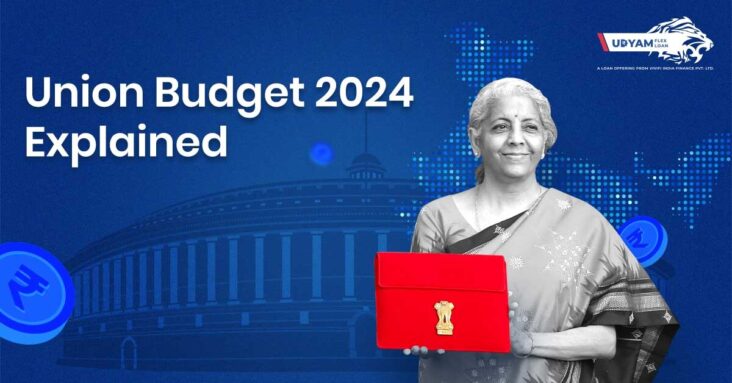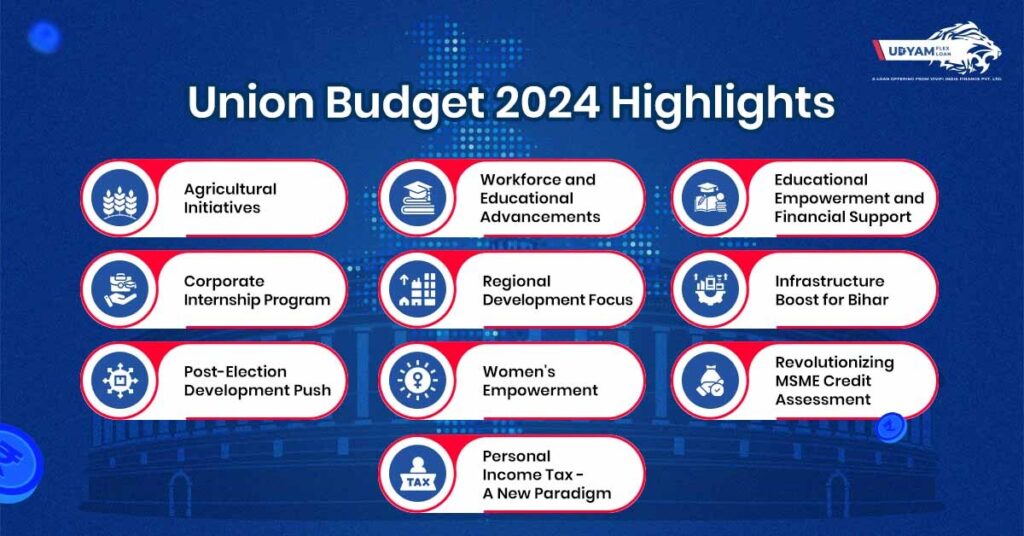Union Budget 2024: Influence on the Indian Economy

Finance Minister Nirmala Sitharaman made history on July 23, 2024, as she presented her seventh consecutive Union Budget, surpassing former Prime Minister Morarji Desai’s record. This landmark budget for fiscal year 2024-25, unveiled a series of significant reforms and initiatives aimed at bolstering India’s economic growth. With nine key priorities identified, ranging from agricultural productivity to next-generation reforms, the Budget introduces substantial changes. The changes include tax adjustments, infrastructure investments, and targeted support for states like Bihar and Andhra Pradesh. These measures are poised to have far-reaching implications for various sectors of the Indian economy and the nation’s overall development trajectory.
In her Budget presentation, Finance Minister Nirmala Sitharaman outlined nine key priorities that will guide India’s economic strategy:
Union Budget 2024 Highlights
- Enhancing agricultural productivity and resilience
- Boosting employment opportunities and skill development
- Fostering inclusive human resource growth and social equity
- Strengthening the manufacturing and service sectors
- Providing robust support for MSME promotion
- Advancing urban infrastructure and development
- Ensuring energy security
- Expanding and modernizing national infrastructure
- Driving innovation, research, and development initiatives
These priorities form the cornerstone of the government’s approach to stimulate economic growth, improve social welfare, and position India for future challenges and opportunities.
- Agricultural Initiatives: The Finance Minister unveiled a suite of measures aimed at revolutionizing India’s agricultural sector. Key announcements include a push towards natural farming practices, a strategic focus on achieving self-reliance in pulses and oilseeds production, and the development of cutting-edge digital public infrastructure for agriculture. These initiatives are designed to enhance farm productivity, promote sustainable practices, and improve farmers’ livelihoods.
- Workforce and Educational Advancements: In a significant move to boost employment and support the workforce, Ms Sitharaman introduced three innovative employee-linked incentive schemes as part of the Prime Minister’s comprehensive package. These schemes are intricately tied to the Employee Provident Fund Organisation and have a threefold focus:
- Recognizing and supporting first-time employees entering the workforce
- Providing assistance to employers to encourage job creation
- Offering direct benefits to employees
This multifaceted approach aims to stimulate job growth, enhance social security, and foster a more robust and skilled labor market.
- Educational Empowerment and Financial Support: In a move to democratize access to higher education, the government has introduced a groundbreaking initiative for students previously untouched by state benefits. This scheme offers education loans of up to ₹10 lakh for studies in domestic institutions, with an annual allocation of e-vouchers to 100,000 students. These vouchers will facilitate a 3% interest subsidy on loan amounts. It will significantly ease the financial burden on aspiring scholars and their families.
- Corporate Internship Program: To bridge the gap between academia and industry, a comprehensive internship program has been unveiled. This ambitious initiative aims to place one crore youth in 500 top-tier companies over the next five years. Participants will gain invaluable exposure to real-world business environments through 12-month internships, enhancing their employability and practical skills.
- Regional Development Focus: The Finance Minister’s speech highlighted a special emphasis on the eastern region of India through the “Purvodaya” initiative. This comprehensive development plan encompasses Bihar, Jharkhand, West Bengal, Odisha, and Andhra Pradesh. With a particular focus on Bihar, the budget outlines several targeted schemes designed to accelerate the holistic growth of these states. It aims to address their unique challenges and leverage their distinct potential for economic advancement.
- Infrastructure Boost for Bihar: Bihar is set for a major infrastructural overhaul with the government earmarking a substantial ₹26,000 crore for expressway development. Infrastructure & Social Spending Fuel India’s Growth and so will this investment. It is part of a broader initiative that includes the establishment of new power projects, airports, medical colleges, and sports facilities. These developments are poised to significantly enhance Bihar’s connectivity, healthcare capacity, and overall economic potential.
- Post-Election Development Push: It will be seen in Andhra Pradesh. The Finance Minister outlined a comprehensive development package for the state. In line with the AP Reorganisation Act, the government has committed to bolstering industrial growth through targeted funding for essential infrastructure. This includes significant investments in water supply systems, power generation, and road networks, laying the groundwork for sustained economic expansion in the region.
- Women’s Empowerment- A Budget Priority: Demonstrating a strong commitment to gender equity and women’s advancement, the budget allocates an impressive sum exceeding ₹3 lakh crore for schemes benefiting women and girls. This substantial investment underscores the government’s dedication to fostering women-led development across various sectors. It will potentially catalyze transformative changes in areas such as education, healthcare, entrepreneurship, and workforce participation for women nationwide.
- Revolutionizing MSME Credit Assessment: In a groundbreaking move for the MSME sector, the Budget introduces a novel credit assessment model for public sector banks. This innovative approach shifts away from traditional external assessments, instead leveraging the digital footprint of MSMEs within the economy. By moving beyond conventional metrics like assets and turnover, this model aims to provide a more holistic and accurate evaluation of MSME creditworthiness. It will help in unlocking new financing opportunities for this vital economic segment.
- Personal Income Tax- A New Paradigm: The Finance Minister unveiled significant changes to the personal income tax structure under the new regime, designed to put more money in taxpayers’ pockets. While maintaining existing tax rates, the revisions focus on expanding tax slabs, offering relief to a wide range of income earners. The most notable change sees the 5% tax slab extended from ₹3-6 lakh to ₹3-7 lakh, with subsequent adjustments to higher income brackets. These modifications could result in tax savings of up to ₹17,500 for salaried employees, representing a substantial boost to disposable income.
Union Budget 2024 Highlights: New Tax Slabs
-
-
- ₹3-7 lakh (previously ₹3-6 lakh): 5% tax rate
- ₹7-10 lakh (previously ₹6-9 lakh): 10% tax rate
- ₹10-12 lakh (previously ₹9-12 lakh): 15% tax rate
- ₹12-15 lakh: 20% tax rate (unchanged)
- Above ₹15 lakh: 30% tax rate (unchanged)
-
This recalibration of tax slabs aims to simplify the tax structure while providing financial relief across various income levels, potentially stimulating consumer spending and economic growth.
Effect of Union Budget 2024 on Indian Economy
Effect of Union Budget 2024 on Indian Economy
The Union Budget 2024 is poised to have a significant impact on the Indian economy, introducing a range of measures aimed at stimulating growth, enhancing inclusivity, and addressing key economic challenges. Here’s an analysis of its potential effects:
- Economic Stimulus: The budget’s focus on infrastructure development, including expressways, airports, and power projects, is likely to boost economic activity. This investment can create jobs, improve connectivity, and attract further private investment, potentially leading to a multiplier effect on economic growth.
- Agricultural Sector Reform:Initiatives promoting natural farming and self-sufficiency in pulses and oilseeds could enhance agricultural productivity and farmer incomes. This may lead to increased rural consumption and reduced dependence on imports, positively impacting the overall economy.
- Employment and Skill Development: The introduction of new employee-linked incentive schemes and the corporate internship program for youth could address unemployment challenges. By bridging the skills gap and providing real-world experience, these initiatives may enhance workforce productivity and employability.
- MSME Support: The new credit assessment model for MSMEs could improve access to finance for this crucial sector. As MSMEs are significant contributors to employment and GDP, this support may lead to increased economic output and job creation. To promote the growth of MSMEs, many loan products like Udyam Flex Loan, would also play a crucial role. With this loan, a business is eligible for an MSME small business loan under relaxed eligibility criteria.
- Tax Reforms: The expansion of tax slabs in the personal income tax structure would increase disposable income for many, potentially boosting consumer spending and economic demand.
- Women’s Empowerment: The substantial allocation for women-centric schemes may lead to increased female workforce participation and entrepreneurship, contributing to more inclusive economic growth.
- Innovation and R&D: Prioritizing innovation and research could enhance India’s competitiveness in global markets and foster the development of high-value industries.
- Fiscal Management: While the budget aims to stimulate growth, its impact on fiscal deficit and inflation will be crucial. The government’s ability to balance spending with revenue generation will be key to maintaining economic stability.
- Foreign Investment: Measures like abolishing the angel tax for certain startup investors could make India more attractive to foreign capital, potentially increasing foreign direct investment.
In conclusion, the Union Budget 2024 presents a multifaceted approach to economic development, with the potential for a significant positive impact. However, its success will depend on effective implementation and the broader global economic context. While Infrastructure & Social Spending Fuel India’s Growth, agriculture, employment, and inclusivity suggest a strategy aimed at sustainable, long-term economic growth for India.
After understanding the union budget 2024 Highlights, it’s evident that a small business can flourish better during this fiscal. Your business too can take the most advantage of it. To grow and expand effectively your MSME small business, you can go with the Udyam Flex Loan and meet the capital needs of your business easily.

